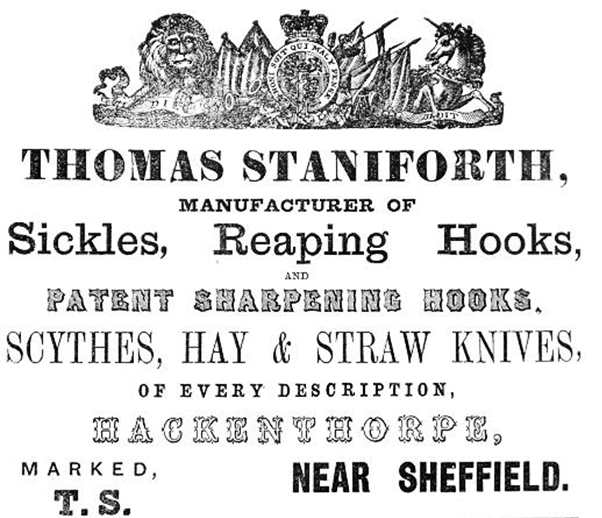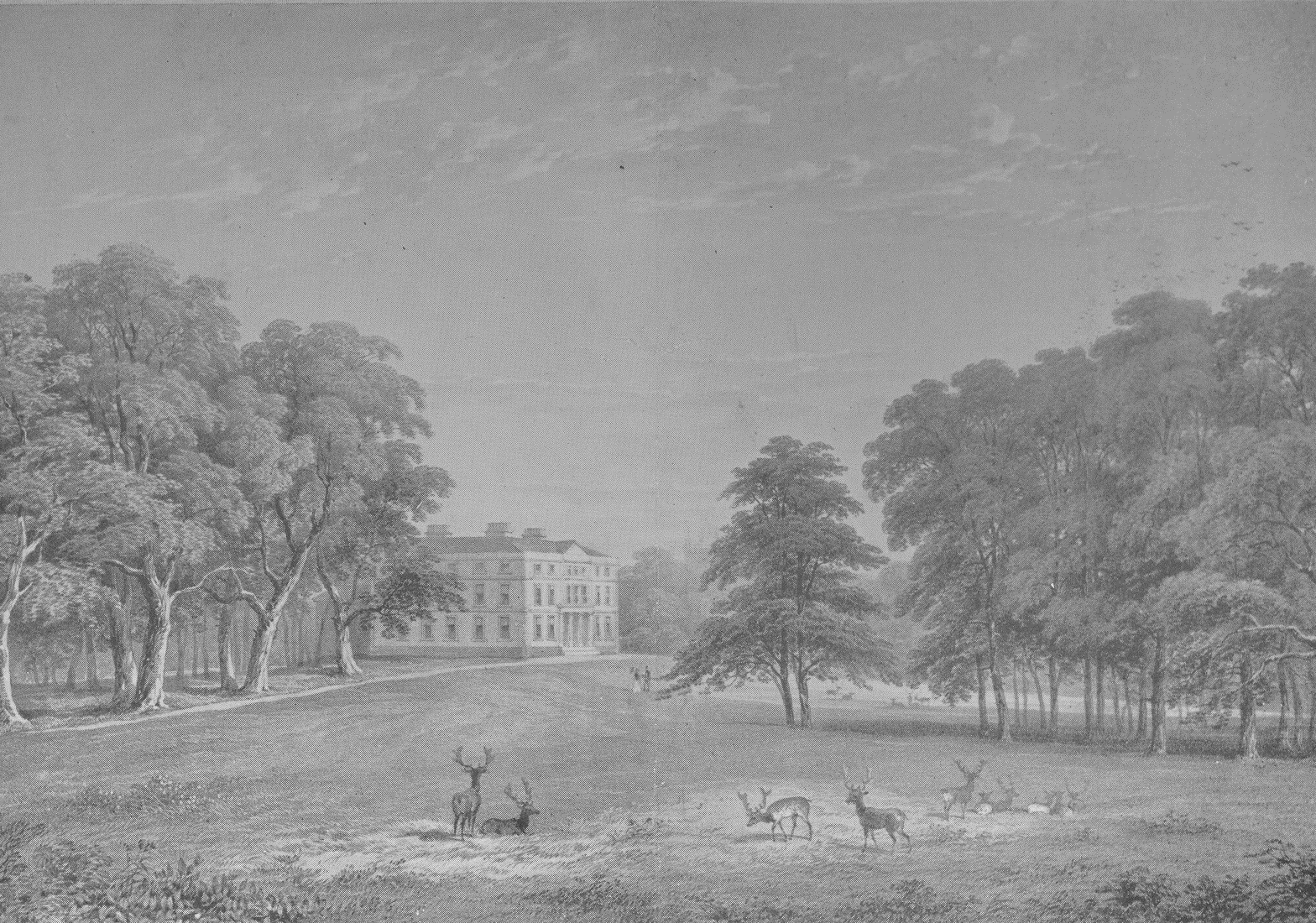
Thomas Staniforth & Co. Sickle works at Hackenthorpe.
 Norton Hall, 1850
Norton Hall, 1850
When it comes to Genealogy, tracing a family back to the 16th Century can be done using Civil and parish records, however most parishes only began recording events such as baptisms, marriages and burials in the mid-1500s, making it quite difficult to trace back to earlier ancestors.
There are a number of documents that may be referred to, such as Wills, Deeds and perhaps the most important, the Manor Court Rolls. The Manor court Rolls record various incidents that were reported and placed before the Court of the Lord of the Manor, incidents include various crimes, or disagreements, and also land transfer between relatives. This is especially useful when a father passes land down to a son, or even a grandson in cases.
When it comes to certain parishes in Yorkshire and Derbyshire we are lucky to have extensive court roll records, one in particular is Eckington, you can view the records relating to the Staniforth’s of Eckington here
One parish in particular that is of great interest, as it was the residence of Henry Staniforth of Herdings, is Norton, near Sheffield. Henry had a son William, baptised in 1560 at St. James Church, before passing away himself in 1575, however other than these two records we have no record of Henry.
An extensive article on Henry Staniforth can be found here
In his 1900 publication titled “Chantreyland: Being an account of the North Derbyshire village of Norton”, Harold Armitage gives great insight into the missing Norton Manor Court Rolls:
“The manor of Norton was extensive, and whereas some parishes contain parts of more than one manor, Norton included not only the whole parish but also Cold Aston (Coal Aston?) in the parish of Dronfield. There were two great courts held for the manor of Norton at Michaelmas and Lady Day, when deeds were enrolled and signed but it is not known where the court rolls of Norton now are, though those of Holmesfield are still safe, and the Duke of Rutland has the manor rolls of Baslow in his keeping; but there are those who hope that the Norton rolls may be found again, because they were in existence towards the end of the eighteenth century and there is no evidence that they have been destroyed. Mr. J.D. Leader used to say he thought they would be found at the Hall, and in Pegge's work on Beauchief there is a reference to some of the manor rolls being in the possession of the Shores, but so far they have not been recovered. A manuscript list of the manors of Derbyshire was presented by Mr. Harrington Shore to Mr. G.H. Marples of Thornbridge Hall, near Longston, about 1892. He had found the list in the monument room at Norton Hall on the death of his father, Mr. Offley Shore, when he was examining and sorting his deeds, and the questions arise, were the manor rolls there too, and into what category were they "sorted"? Not for the bonfire let us hope; but it is disconcerting to be told that after the crash of 1843 the Shores had a cart body full of deeds burned in the saddle-room at the Hall, though a few were saved by William Swift the genealogist. It is a pity that all the documents were not handed to him, for he would have made the right use of them. He was assistant distributor of stamps in Sheffield, but his hobby was family history, and his knowledge was both wide and deep. He was born in 1818, and dying in 1873 was buried in Norton Cemetery, where there is an appropriately unobtrusive and tasteful memorial. A son who was deaf and dumb lies there too, and upon the occasion of his internment a lady amongst the mourners mentioned to the superintendent of the cemetery that the boy was deaf and dumb, and whereupon, with the true North-country readiness for a joke, even upon the grimmest occasions, he replied "This cemetery is for nobody else" and the mourner, in no mood to detect double meanings, nor expecting them at such a time, looked round aghast that there should be so many gathered together in one cemetery who had been unable to hear or speak.
Nearly Thirty years ago Mr. Addy sought diligently for the Norton rolls, but without success. Mr. Charles Jackson of Balby, Doncaster, wrote to him at the time that Mr. Hunter said once there was a vast number of old deeds and papers in boxes in a hay-loft at Norton. He called it "a singular and beautiful collection," and he only obtained access to it in 1848, when it was entrusted to Mr. Samuel Mitchell, after the Shores' misfortune, "ubi nune?"
Mr. J.D Leader made another attempt to discover the rolls in 1881 by inserting a notice in the Sheffield Independent (April 7) asking if "any one can give information as to where the ancient Court Rolls of the Manor of Norton, near Sheffield, are now to be met with? The late Mr. Hunter, in a memorandum he has left, states that there was once a large collection of conveyances respecting Kilnhurst (and perhaps other places also) which were in several boxes in a hay-loft at Norton Hall. These, he says, were placed by Mr. O. Shore's assignee in the hands of Mr. Samuel Mitchell at whose house he (Mr. Hunter) saw them on August 8, 1848. Does any one know what further became of these?"
Pegge made use of the court rolls when he traced descent of the manor, and Mr. Addy says that much of Dr. Pegge's information seems to have been sent to him by the Rev. T. Halladay. Now there is much for which we have to thank Mr. Halladay. He read the rolls of the Norton Manor court, and compiled a skillful summary of the entries, so that though the rolls themselves have disappeared we are not in Egyptian darkness concerning their contents.
When James Pilkington, Unitarian minister of Derby, wrote A View of the Present State of Derbyshire, with an account of its Most Remarkable Antiquities, which was published in 1789, he stated that "the rev Mr. Halliday (Halladay) of Norton, who has examiner the court rolls, has been so obliging as to furnish me with the following particular, which he has extracted from them" The particulars furnished by Halladay which appear also in A Historical and Description View of Derbyshire from the Remotest Period to the Present Time, by David Peter Davids, Unitarian minister for Belper and Milford, published in 1811, show us that "Formerly two great courts were held here regularly every year. The principal business transacted on those occasions was examining into, and punishing offences, by which the inhabitants of the manor were or might be injured. The following in particular are noticed: encroachments upon the waste, altering water courses, neglecting to scour or cleanse ditches, turning a scabbed horse on to the common, shutting up a bridle road, giving an account of wafes and strays, examining those who brewed or baked for sale with a license from this court and amercing them for such offences."”
When looking back at the said book Harold Armitage references, written by James Pilkington, we see he goes into even greater detail:
"Two ale tafters were also appoitned at the court; and it appears, that there were brewed in the parish love-ale, for all which fines were levied. Those who had committed an assault, and drawn blood, were fined separately for each offence. Some also were fined for carrying staves or clubs, lodging suspicious persons, and remaining in alehouses after eight o'clock at night. The inhabitants of the parish were also obliged to make two butts to shoot at, and keep them in repair under certain penalties; and to provide their sons and men servants with bows and arrows as late as the thirtieth year of Queen Elizabeth. The stocks were to be kept up, and every gap in their fences to be made up before Lady Day.
In the thirty-fourth year of Queen Elizabeth upwards of one hindred and thirty suitors were amerced for non-appearance, and other offences. Of this number were eleven brewers for selling ale unlawfully, and twenty-one persons for playing at unlawful games, as huddlings. If a frank pledge neglected to appear at court heavy penalties were inflicted. There is no appearance of cock-fighting, horse racing, throwing at cocks, no cards, or dice, nay what is more wonderful, no ducking of witches, or even a ducking stool is noticed. The parish of Norton consists of several hamlets; and in the year 1784 contained two hundred and seventy eight houses."
Over one hundred years following Harold Armitage’s publication, and we are still none the wiser as to the location of the Norton Manor Court Rolls, it seems likely at this point that the records have unfortunately been destroyed, Mr. Halladay’s transcript also appears to have been lost over time. Although we can never give up hope